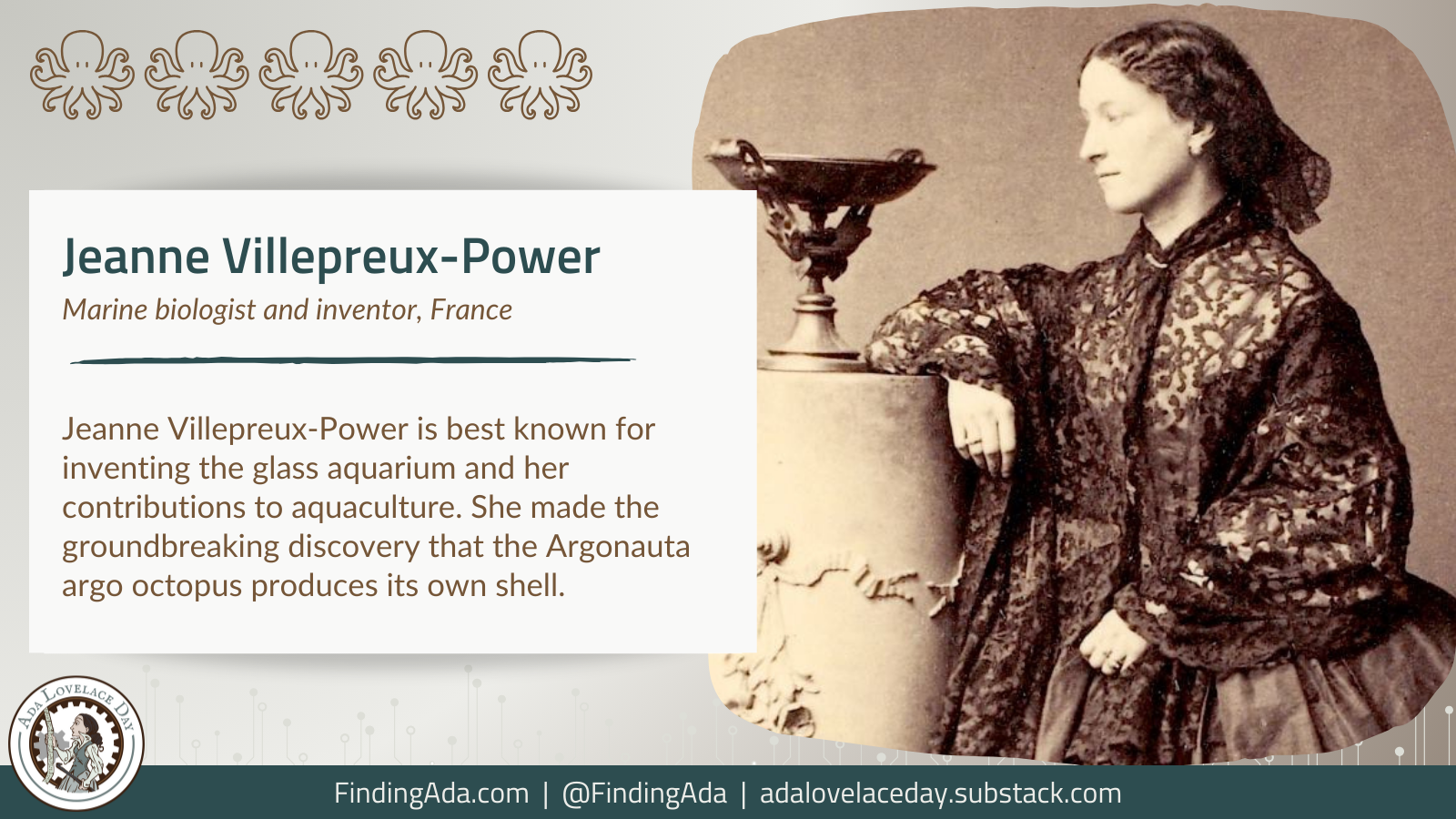Jeanne Villepreux-Power
Known as the “mother of aquariophily”, Jeanne Villepreux-Power was a French marine biologist and the inventor of the glass aquarium. At a time when women were excluded from the scientific establishment, she made revelatory discoveries about aquatic species, notably that the Argonauta octopus produces its own shells.
She was born Jeanne Villepreux in September 1794 in Juillac, Corrèze, a rural part of southern France. Legend has it that she walked all the way to Paris at the age of 18, where she eventually became a successful dressmaker and married the merchant James Power in 1818. The couple then moved to Messina in Sicily, a harbour city that would become the site of Villepreux-Power’s astonishing scientific achievements.
In Sicily, Villepreux-Power – who had no formal education but was able to read, write and sketch – could pursue her voracious interest in subjects including geology and natural history. She made careful observations and collected specimens of local flora and fauna during walks around Messina, becoming particularly fascinated with molluscs and one of their most mysterious predators: the small octopus Argonauta argo.
This cephalopod had been the subject of myth and conjecture since the time of Aristotle, who believed it may have travelled along the surface of the ocean like a boat (with its sail-like membranes propelling its shell across the water). In Villepreux-Power’s time, the prevailing theory was that the Argonauta acquired its spiral shell from a different organism, much like a hermit crab. But through groundbreaking research, she proved that the Argonauta produces its own shell.
This wasn’t a simple discovery. “As soon as [the Argonauta] perceives that it is being observed, it withdraws its membranes into its shell in the blink of an eye and flees to the bottom of the cage or the sea, reemerging to the surface only when it thinks it is safe from all danger,” Villepreux-Power wrote. And so she devised the first glass aquarium in 1832, an invention which is recognised as her greatest contribution to marine biology. Her design was a forerunner to the model still used to study marine life today and it allowed her to observe the octopus without it being aware of her presence.
After five years of studying the Argonauta, she concluded that it grew its own shell, which it could repair using its own substance and broken shell pieces. Villepreux-Power reported her results to multiple European scientific societies, and the respected biologist Sir Richard Owen presented her research to the London Zoological Society in 1939. Some male scientists cast doubt on her (correct) claims, but soon, they were published across Europe.
Villepreux-Power published two books about her experiments, as well as the first studies into Argonauta reproduction. Overall, her research laid the groundwork for later discoveries about octopus intelligence and consciousness. She was also interested in conservation and is considered a pioneer in aquaculture, today recognised as an environmentally responsible form of fish farming.
During her lifetime, Villepreux-Power became a member of more than a dozen esteemed scientific academies and institutions, an achievement almost unheard of for women at the time. Tragically, most of her scientific collections, writings and other materials were lost in a shipwreck in 1838. Evidence of her work survived, but she stopped publishing and divided her later years between Paris and London – returning to her hometown of Juilliac shortly before her death on 25 January 1871, aged 76.
In 1997, the Magellan probe discovered a new crater on Venus. It was named Villepreux-Power, after the woman whose own discoveries opened up new vistas of scientific understanding.
Further Reading
- Jeanne Villepreux-Power, Wikipedia
- Jeanne Villepreux-Power: Marine Biologist and Inventor of the Aquarium, Susan Fourtané, Interesting Engineering, 25 September 2018
- History’s Hidden Figures: Meet the 19th Century French Dressmaker Who Invented the Aquarium, Katherine Handcock, A Mighty Girl, 24 September 2022
- A 19th Century Shipwreck Might Be Why This Famous Female Naturalist Faded to Obscurity, Maris Fessenden, Smithsonian Magazine, 2 June 2015
- The Seamstress Who Solved the Ancient Mystery of the Argonaut, Pioneered the Aquarium, and Laid the Groundwork for the Study of Octopus Intelligence, Maria Popova, The Marginalian, 26 December 2022
- Jeanne Villepreux-Power, Nika Mušič, She Thought It, 29 January 2018
- Jeanne Villepreux-Power, Natural Historian and Marine Biologist, Jill M. Staake, S.T.E.A.M. Powered, 17 May 2015
- The Mother of Aquariophily, Jeanne Villepreux-Power and the Mystery of the Paper Nautilus, Dr Ele Willoughby, Minouette, 11 December 2019
Written by Moya Crockett, with thanks to Stylist for their support.
